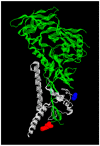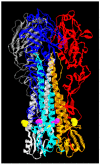The Proteolytic Regulation of Virus Cell Entry by Furin and Other Proprotein Convertases
- PMID: 31505793
- PMCID: PMC6784293
- DOI: 10.3390/v11090837
The Proteolytic Regulation of Virus Cell Entry by Furin and Other Proprotein Convertases
Abstract
A wide variety of viruses exploit furin and other proprotein convertases (PCs) of the constitutive protein secretion pathway in order to regulate their cell entry mechanism and infectivity. Surface proteins of enveloped, as well as non-enveloped, viruses become processed by these proteases intracellularly during morphogenesis or extracellularly after egress and during entry in order to produce mature virions activated for infection. Although viruses also take advantage of other proteases, it is when some viruses become reactive with PCs that they may develop high pathogenicity. Besides reacting with furin, some viruses may also react with the PCs of the other specificity group constituted by PC4/PC5/PACE4/PC7. The targeting of PCs for inhibition may result in a useful strategy to treat infections with some highly pathogenic viruses. A wide variety of PC inhibitors have been developed and tested for their antiviral activity in cell-based assays.
Keywords: furin; proprotein convertases; protease inhibitors; proteases.
Conflict of interest statement
The author declares no conflict of interest.
Figures



Similar articles
-
How Do Enveloped Viruses Exploit the Secretory Proprotein Convertases to Regulate Infectivity and Spread?Viruses. 2021 Jun 25;13(7):1229. doi: 10.3390/v13071229. Viruses. 2021. PMID: 34202098 Free PMC article. Review.
-
Diversity in Proprotein Convertase Reactivity among Human Papillomavirus Types.Viruses. 2023 Dec 26;16(1):39. doi: 10.3390/v16010039. Viruses. 2023. PMID: 38257739 Free PMC article.
-
Pro-protein convertases (PCs) other than PC6 are not tightly regulated for implantation in the human endometrium.Reproduction. 2007 Jun;133(6):1189-97. doi: 10.1530/REP-06-0285. Reproduction. 2007. PMID: 17636173
-
Regulation of prohepcidin processing and activity by the subtilisin-like proprotein convertases Furin, PC5, PACE4 and PC7.Gut. 2008 Nov;57(11):1573-82. doi: 10.1136/gut.2007.141812. Epub 2008 Jul 29. Gut. 2008. PMID: 18664504
-
Proprotein convertases regulate trafficking and maturation of key proteins within the secretory pathway.Adv Protein Chem Struct Biol. 2023;133:1-54. doi: 10.1016/bs.apcsb.2022.10.001. Epub 2022 Nov 18. Adv Protein Chem Struct Biol. 2023. PMID: 36707198 Review.
Cited by
-
Semantic and Population Analysis of the Genetic Targets Related to COVID-19 and Its Association with Genes and Diseases.Adv Exp Med Biol. 2023;1423:59-78. doi: 10.1007/978-3-031-31978-5_6. Adv Exp Med Biol. 2023. PMID: 37525033
-
Cathepsin L in COVID-19: From Pharmacological Evidences to Genetics.Front Cell Infect Microbiol. 2020 Dec 8;10:589505. doi: 10.3389/fcimb.2020.589505. eCollection 2020. Front Cell Infect Microbiol. 2020. PMID: 33364201 Free PMC article. Review.
-
The spike glycoprotein of the new coronavirus 2019-nCoV contains a furin-like cleavage site absent in CoV of the same clade.Antiviral Res. 2020 Apr;176:104742. doi: 10.1016/j.antiviral.2020.104742. Epub 2020 Feb 10. Antiviral Res. 2020. PMID: 32057769 Free PMC article.
-
OFF-State-Specific Inhibition of the Proprotein Convertase Furin.ACS Chem Biol. 2021 Sep 17;16(9):1692-1700. doi: 10.1021/acschembio.1c00411. Epub 2021 Aug 20. ACS Chem Biol. 2021. PMID: 34415722 Free PMC article.
-
Furin cleavage sites in the spike proteins of bat and rodent coronaviruses: Implications for virus evolution and zoonotic transfer from rodent species.One Health. 2021 Dec;13:100282. doi: 10.1016/j.onehlt.2021.100282. Epub 2021 Jun 22. One Health. 2021. PMID: 34179330 Free PMC article. Review.
References
-
- Basak A., Zhong M., Munzer J.S., Michel Chretien M., Seidah N.G. Implication of the proprotein convertases furin, PC5 and PC7 in the cleavage of surface glycoproteins of Hong Kong, Ebola and respiratory syncytial viruses: A comparative analysis with fluorogenic peptides. Biochem. J. 2001;353:537–545. doi: 10.1042/bj3530537. - DOI - PMC - PubMed
Publication types
MeSH terms
Substances
LinkOut - more resources
Full Text Sources
Other Literature Sources
Medical

